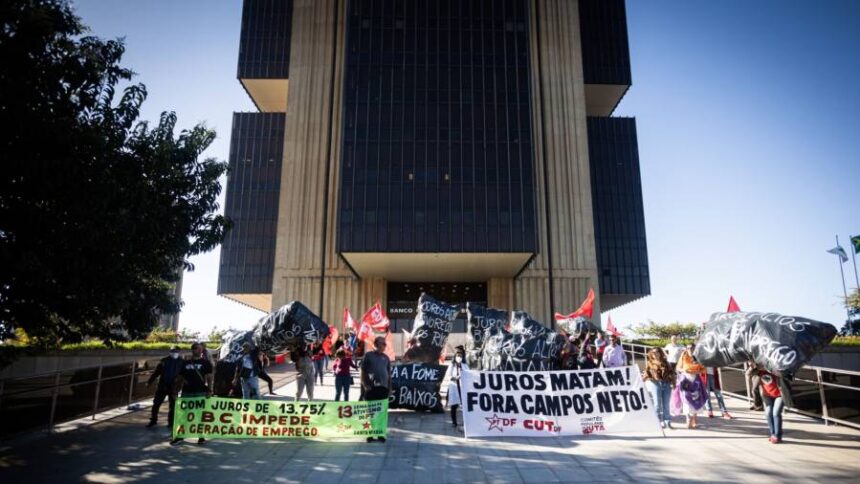Receive free Central banks updates
We’ll send you a myFT Daily Digest email rounding up the latest Central banks news every morning.
Brazil, one of the nimblest and most aggressive emerging markets to raise interest rates, has begun loosening monetary policy as Latin America reaps the benefit of moving faster than G7 nations to fight inflation.
The Banco Central do Brasil on Wednesday evening announced a half-point reduction, taking its Selic lending benchmark to 13.25 per cent. It was a greater drop than the 25 basis point cut most economists had expected, and the central bank signalled that further reductions of the same magnitude were likely in the months ahead.
Last Friday, Chile became the first big economy in the region to reduce rates post-pandemic, cutting borrowing costs by a full percentage point to take them down to 10.25 per cent.
“Even if the fight against inflation is not finished, Latin American central banks can take a victory lap,” said Ernesto Revilla, chief Latin America economist at Citi in New York. “They distinguished themselves in this cycle . . . by their discipline, autonomy, commitment and clear communication. Monetary policy in the inflation targeters — Chile, Brazil, Mexico, Peru and Colombia — is giving a lesson to the world.”
In a series of hawkish moves that began in March 2021, Brazil’s rate-setters jacked up the Selic from an all-time low of 2 per cent, countering the inflationary effects of generous public spending and rate cuts unleashed in response to the Covid-19 crisis. The US Federal Reserve did not start raising rates until a year later in March 2022. The European Central Bank was even slower, first tightening policy in July last year.

The inflation-fighting benefits of Brazil’s early rate rise are now clear.
After peaking in low double digits, consumer price growth in Latin America’s largest economy slowed to 3.2 per cent in the 12 months to June, below this year’s official target. In Chile, headline annual inflation is 7.6 per cent, almost half the 14.1 per cent peak recorded in August last year.
“Latin America was ironically more successful because central banks didn’t have the credibility that the Fed had and didn’t have the luxury to say: ‘Ah, this is just a transitory phenomenon, inflation will go up and come down by itself’,” said Claudio Irigoyen, head of global economics at Bank of America in New York. “The Fed was probably one year late in the game.”
Although Brazil’s central bank has won international plaudits for bringing inflation under control, at home it has faced strong criticism for its hawkishness.
Leftwing president Luiz Inácio Lula da Silva has accused governor Roberto Campos Neto of “playing against the Brazilian economy” and has called into question the central bank’s independence, which was granted two years ago under his hard-right predecessor Jair Bolsonaro.
Brazil’s tight monetary policy may have constricted the economy, but it has not killed growth. Economists are upgrading their forecasts after an unexpectedly strong first quarter for the key agricultural sector and Citi expects gross domestic product to expand 2.3 per cent this year.
Cristiano Oliveira, chief economist at commercial lender Banco Pine in São Paulo, said before the decision that cutting rates this month was “technically the most correct decision”.
“Core inflation measures have shown a strong deceleration, indicating that monetary policy was successful,” he said. “The [central bank] realised in advance that the main component [of inflation] was strong demand and therefore monetary policy should be tightened.”
While it signalled the start of a “gradual” cycle of monetary easing, the Banco Central do Brasil also warned on Wednesday that inflation would increase over the second half of the year.
Andrea Damico, chief economist at asset manager Armor Capital, correctly predicted a 50bp cut.
“A drop in interest rates is not premature. We see a very consistent drop in [inflation] expectations, especially for the long term,” she said. “We also believe it will probably signal that 50 [basis] points is a suitable pace for the next meeting.”

Other economists think Brazil risks acting too quickly.
“Service inflation remains high, inflation expectations are still not fully anchored and the labour market is without slack,” said Alexandre Soriano, head of macro research at Bahia Asset Management in Rio de Janeiro. “In an environment of significant fiscal expansion, it would make sense for the central bank to postpone the beginning of its cycle of cuts.”
Mexico, Latin America’s second-biggest economy, faces a different challenge.
Its close links to the flourishing US economy have kept headline inflation high at 5.1 per cent in the year to June. “Inflation in Mexico is still pretty sticky, especially services inflation,” said Irigoyen.
Growth remains strong.
Economists polled by Citi expected Banco de México to postpone rate cuts until December — and then are expected to cut them by just a quarter point.
Argentina stands out as an exception among Latin America’s big economies.
The Peronist government’s fondness for printing money to fund public spending and its heavily distorted official exchange rates have stoked inflation to more than 115 per cent a year. Interest rates in effect stand at an annual level of 155 per cent.
Eric Parrado, chief economist at the Inter-American Development Bank in Washington, praised Latin American central banks’ generally rapid and effective response to inflation. But he warned against overhasty rate cuts.
“The central banks can’t declare victory yet,” he said. “They must be careful since there is still a lot of uncertainty over whether the measures of core inflation, without energy and food costs, have established a clear falling trend.”








